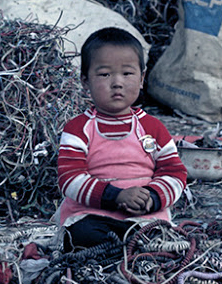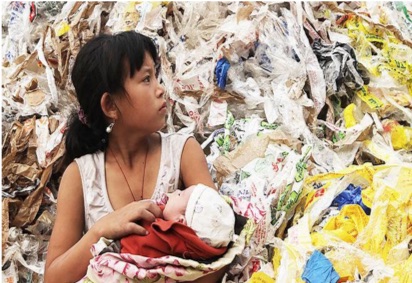View on The Global Environmental Justice site
Curator
Rajashree Ghosh
Resident Scholar, Women’s Studies Research Center, Brandeis University
Why I selected this film
RiverBlue documents the profound impact of textile factories serving the fashion industry in Western countries on the rivers in Bangladesh, China, India, Indonesia, UK, USA, and Zambia. The film connects the consumer appetite for cheap and trendy garments with a rapid increase in the profitable but unsustainable production of disposable clothing. The film visits communities that rely on their waterways for food, livestock, and sustenance, and it chronicles the devastating effects of untreated wastewater from the factories. The polluted water harms the local aquatic life, contaminates crops, and eventually reaches the ocean to spread around the globe.
Overall, the film educates the viewer on the issues of environmental degradation, global trade agreements, workers’ rights, and hazardous working conditions. As a teaching tool, the film is more than a critique of the fashion industry; it also explores alternative and responsible manufacturing processes that can help resolve this global problem.
Suggested subject areas
Agriculture, Ethics, Political Science, Business Management, Geography, Population Studies, Economics, Global Studies, Public Policy,Environmental Studies, Legal Studies
Teacher's guide
Please see the teacher's guide for maps, background information, suggested subjects, questions and activities.
Synopsis
Conservationist Mark Angelo explores the pollution of major international rivers caused by the clothing industry’s irresponsible disposal of toxic chemical waste. The impact on Bangladesh’s Buriganga, China’s Pearl River, India’s Ganges, and Indonesia’s Citarum—and the people who depend on these rivers—is severe. Toxic dyes and heavy metals from textile manufacturing and leather tanning are frequently dumped directly into these rivers in countries where regulations are lax, poorly enforced, or both. The textile and tannery sectors alone account for 20% of the world’s freshwater pollution, says Angelo, but they don’t get anywhere near the level of scrutiny that other big polluters receive.
The film includes interviews with local activists, investigators, and manufacturers as it sheds light on a crisis affecting some of the world’s most significant waterways. Although it focuses on the pollution produced by the blue jean manufacturing and tannery sectors, the film also explores the latest technologies and cutting edge alternatives and solutions to the problem that could greatly reduce the industries’ water consumption and the dumping of waste.
The global environmental justice focus of the film
Supported by international trade agreements, fashion companies have outsourced manufacturing and jobs to China, India, Indonesia, Mexico, and other countries where environmental regulations and laws protecting workers and the environment are lax. RiverBlue draws attention to the toxic living and working conditions experienced by workers and their families and the impact of the toxic waste on their health and the environment.
Many workers must perform their jobs in dangerous and unsanitary conditions with continuous exposure to toxins, reflecting the disproportionate exposure of poorer populations to environmental risks in their homes and workplaces. The fashion brands that benefit from these profitable industries often escape responsibility for the damage to the environment and to the workers’ health. RiverBlue argues that alternatives to the current practices do exist, and they could be more widely adopted. Consumer activism, the film suggests, could pressure companies to adopt more sustainable and less polluting practices.
REVIEWS
https://www.curiouslyconscious.com/2018/01/riverblue-documentary-film-review.html/
Last week I had the pleasure of watching eco fashion documentary Riverblue on the big screen. It was my first time seeing the film (surprisingly, I’d not heard of it until this year!) and I was excited to see how we’re progressing from filthy fashion norms to new innovative methods.
The screening was held by Advaya Initiative, an environmental and wellbeing platform set up by sister duo Ruby and Christabel Reed. Their organisation hosts events spreading awareness and positivity for the planet, spanning yoga and nature retreats to slow fashion talks.
About Riverblue
The Riverblue film came out in 2016, but its contents is still relevant – if not more relevant – today. If you’re anything like me, you dived into watching ethical fashion documentaries when first asking the question #WhoMadeMyClothes and were shocked to discover that fashion negatively affects so many people and places. The number one cited documentary is The True Cost, but Riverblue could easily be its sequel.
The film documents how our planet and people’s welfare is quite literally being sold down the river in return for fast fashion trends and stonewashed jeans. International river conservationist Mark Angelo travels across the world (to Bangladesh, India, China, Italy, and even London) documenting the harsh chemical manufacturing processes and the irresponsible disposal of toxic chemical waste from clothing manufacturers.
Shock factor
Throughout the film, you see instances of people and rivers being exposed to harmful chemicals, rivers getting frothy from filthy dyes and treatments used on clothing.
It was sad to see that in India, the sacred river Ganges is also affected. The river is historically revered to cleanse all that wade into it, and yet it’s not untouched from the factories dumping waste in it. Sadder still is the hesitance of the people who pay respect to the Ganges, who don’t want to deny its cleansing powers and recognise that something needs to be done to stop it from being polluted.
Outsourcing the responsibility
In one section of the film, you see members of Greenpeace take samples of waste being dumped into a river from a clothing manufacturer, and they confirm its toxicity. Yet when they reach out to brands who use the factory, such as Gap, they’re given a run-of-the-mill response saying the brand has a policy to only work with suppliers who dispose of their waste responsibly. It’s PR-speak at its finest, and it shows the real issue here – western brands governed by western laws are making the most of less developed countries and their illegitimate activities in order to make profit.
What angers me the most…
While I rarely speak about my disappointment and despair for the way a lot of commercial, fast fashion brands operate (preferring to sing the praises of more responsible slow fashion), I can’t hold back the fact that a lot of big fast fashion brands are abusing people and the planet in order to get richer. It’s not to get rich, it’s not even to survive – it’s to get richer still.
I know that when I write about ethical fashion, I do so from a seat of privilege – one that already has water, food, shelter, and relationships taken care of. I know that for most, their worries needn’t be stretched to the sourcing of their clothes, items, holidays, because they need to focus on looking after themselves and their closest relations. But I’m also mightily aware of big fashion brands that serve people who can afford to buy better, who have enough disposable income to enjoy whimsical trends and have multiple versions of the same garment. And they should be the ones who source responsibly, pay fair wages, and don’t screw down on their costs at the detriment of their workers – whether outsourced or not – and the planet to increase their profit.
If you have the opportunity to purchase better, please spend the time looking for more ethical fashion brands, or at least be aware of the best places to shop on the high street. The Fashion Transparency Index by Fashion Revolution is a brilliant place to start, or feel free to ask me for recommendations.
Stonewashing 2.0
I have to add that the film isn’t all doom and gloom. It takes stonewashed jeans as an example of how a simple wardrobe staple can have dirty beginnings (using strong chemicals such as potassium permanganate to get the stonewashed effect) and how innovation is changing that – whether it’s through using powdered crab shell waste, lasers, or big drums full of stones. It’s a step in the right direction, and if we can support it by buying from manufacturers who care, we’re encouraging the next steps too.
If you are indeed looking for a good pair of jeans (good meaning good fit, style and story), here’s my newly-updated guide to ethical denim and jeans. Photo credit: Freestocks.org
REVIEW BY ISADORA LAMBERT FOR VIDEO LIBRARIAN
https://videolibrarian.com/topics/global-environmental-justice-collection/
Four stars ****
This educational documentary would be especially impactful to students and library patrons interested in topics like political science, geography, global studies, public policy, environmental studies, and sustainable fashion.
RiverBlue is a powerful documentary that examines how unsustainable practices within the textile industry impact the world. The host of the film, conservationist Mark Angelo, investigates chemical waste in the world’s rivers, traveling to places like Bangladesh, India, and China. The film shows the effect this pollution has on natural environments and the communities surrounding them.
The film shows toxic practices in the textile industry by focusing on the manufacturing of blue jeans. RiverBlue examines this sector of the textile industry from several angles. It addresses historical events that led to the production of garments moving outside of the United States and how the rise of fast fashion has made production become more and more unsustainable. RiverBlue exposes details like the astounding amount of water required to produce a single pair of jeans, and how carcinogens in dyes used to stonewash jeans affect wildlife.
RiverBlue highlights the importance of seeing the evidence of contamination. Mark Angelo thoroughly explores the rivers he travels to, exposing details like the smell of sewage and industrial pollution in the Buriganga River in Bangladesh and the black viscous water present at some rivers throughout China. The film also portrays the effects of chemical waste on human life, which can manifest in physical ways such as rashes, boils, limb numbness, and cancer.
RiverBlue is a valuable teaching tool that can educate and inspire viewers to take action against the unsustainability of fast fashion. Although the effects of pollution can be upsetting to view, the film is not without hope, as it also examines the importance of activism, conservationism, and new sustainable practices. RiverBlue explains that the massive global impact of chemical waste is hidden from the public, underscoring the importance of the details exposed in this documentary.
What academic library shelves would this title be on?
This educational documentary would be especially impactful to students and library patrons interested in topics like political science, geography, global studies, public policy, environmental studies, and sustainable fashion.
How does this film contribute to a discussion of environmental or climate justice, and/or environmental literacy?
RiverBlue contributes to discussions of environmental literacy by showing viewers firsthand accounts of the effects of contamination. The film inspires both discussion and action against climate change.
Can this film be used in a library education program?
The film is available in both a 95-minute theatrical version and a 53-minute broadcast version, making it an ideal choice for a library education program.



